Furniture Blog
Custom Furniture Gallery
Restoring an historic handrail
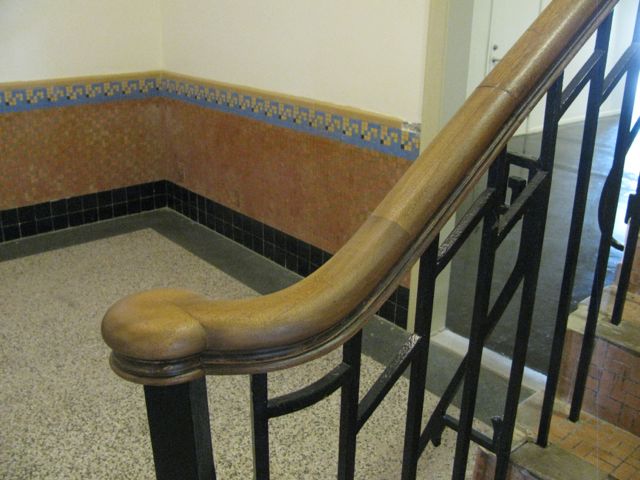
It doesn't look like 20 hours of work, but there's some tricky business in a little project like this piece of handrail.
Last year I spent 9 months working on an historic preservation project in Clovis, NM. The Hotel Clovis was, in it's heyday, a prety big deal. When it was built in 1930 it was the biggest building between Dallas and Los Angeles. The Glen Miller orchestra, Louis Armstrong, and Bob Wills all played dances in the ballroom on the second floor of the hotel. It was a big stop on the railroad and is just down the street from the railroad station and the Harvey Hotel. By the late 70"s the hotel was in decline and when the train quit stopping, it was the death knell.
After being abandoned for 25 years or so, a developer from Santa Fe took on the project of turning the hotel into low income housing. Since somone along the way had gotten it put on the Historic Register, the place had to be restored instead of simply being gutted.
So, the last part of the restoration that I worked on was the 18" piece of missing handrail where the staircase comes down into the lobby. Since this is historic preservation we're talking about, I couldn't simply toss out the remaining handrail and start from scratch with something off the shelf. Instead I had to make a chunk of handrail to match the existing.

This is how it looked when I started working on it. You can see the part that was remaining of the original handrail setting on the metal balustrade. The missing piece needed to run straight for about 9" then start a compound curve that swung from it's pitch to level and off to the right about 45 degrees ending in a volute of some sort. Since there were no other examples of volutes left in the building, I was going to have to make up something that seemed appropriate to the period.
The first issue was how to take this complex shape with me back to the shop so I could build it and know that it was going to fit. After thinking about several options for templating it I finally settled on scribing and laminating several layers of bender board (plywood where almost all the laminations go in one direction allowing it to be flexible in one direction) to the existing balustrade. By laminating them together I could get them to hold their shape.
Here I've taken two strips of bender board, held them to the balustrade and scribed the shape onto them. Then I jig sawed the shape out and I'm in the process of hot melt gluing the two strips together.
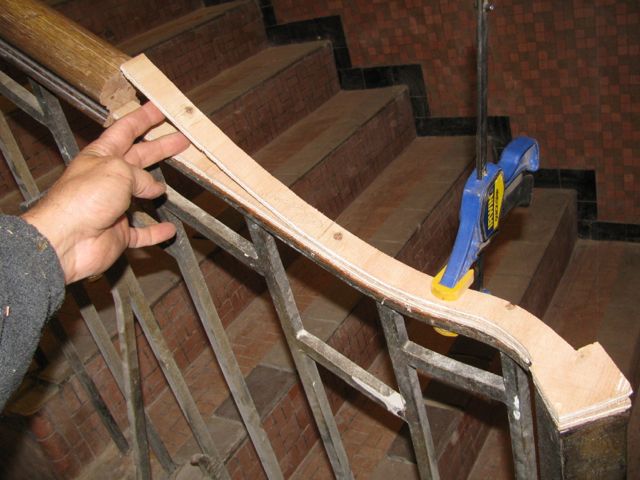
The next step was to scribe some side pieces to the bender board so that it would hold it's shape vertically as well as horizontally. This gave me an exact template of the complicated shape.
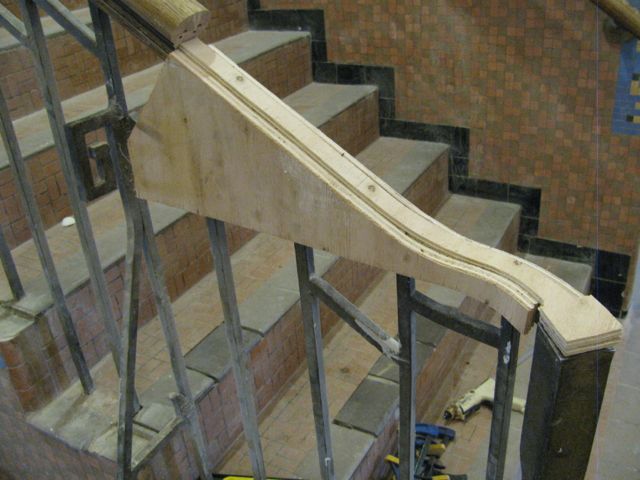
When it was all hot melt glued together it was nice and rigid and could be popped off of the balustrade and be taken back to the shop.
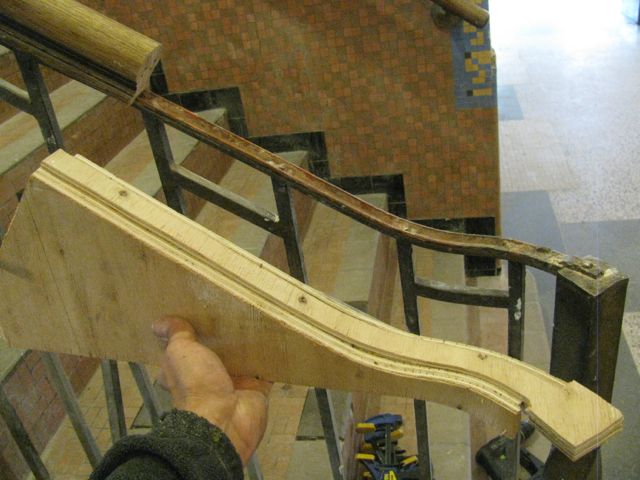
In the photo below you can see what the cross section of the handrail is. There's an eliptical shape on the top, with fillets and coves below and a small half round shape on the bottom. If I only had to make a straight section of this shape I could've had a custom cutter made for my shaper and just run both sides of the handrail on it. Since I needed to take this shape around a compound curve I had to approach things differently.
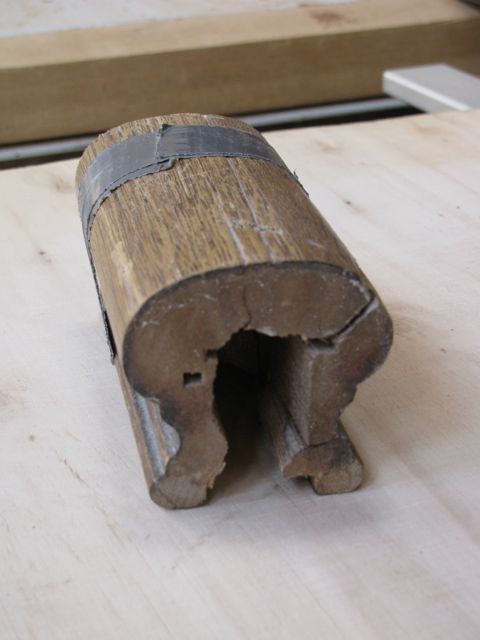
The first step was to make some oversized blanks for the three parts of the completed piece; the straight section, the curved piece and the volute. The straight section was simply ripped on the table saw. The volute was a square blank that was then turned on the lathe. The curved piece had to first be shaped to the vertical curve and then scribed to the horizontal curve from the template. Here are the 3 blanks sitting on the template. The curved section has been bandsawed and handplaned to match the vertical curve and glued up wide enough to be scribed to the horizontal curve.
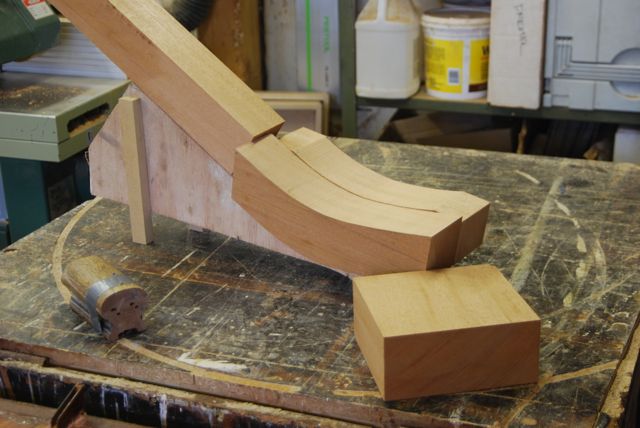
Here you can see the curved section being scribed for the horizontal curve from the template. At this point I'm leaving all the blanks oversized by 1/4" or so. This allowed me to take them all back to the site, put them in place on the balustrade and do a precise scribe from the existing piece in place. That guaranteed that all the pieces would line up perfectly on the balustrade in the end.
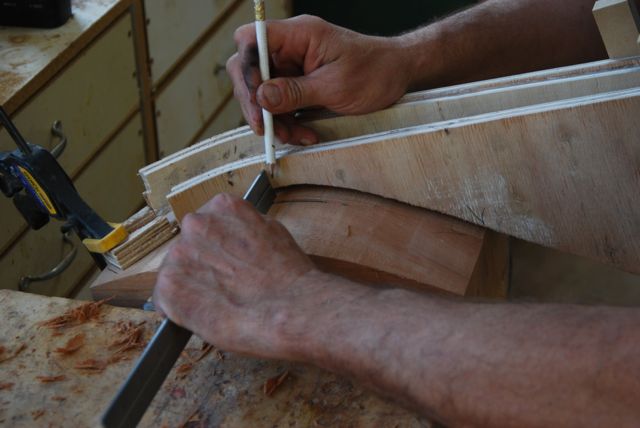
The next step was to bandsaw out the curved section. The geometry on this kind of compound curve is a little weird. What exactly, is square to what? To keep all the plumb lines plumb while bandsawing, I made a quick jig to hold the blank up at the angle that it would eventually live at and ran it through the saw like that.
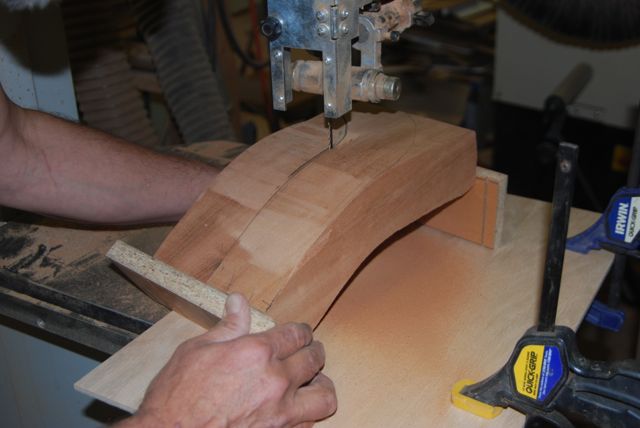
This is what it looked like when the curved section was cut out of it's blank. The two outside pieces get tossed in the woodstove.
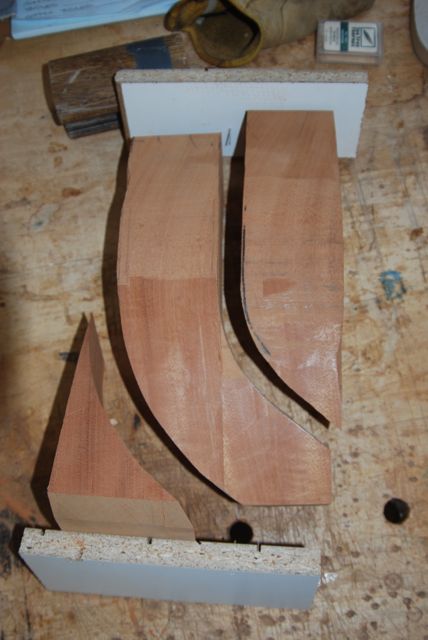
After turning the volute on the lathe I screwed it to a square piece of plywood and made two 45 degree cuts on the table saw to cut out a birds mouth that the curved section would fit into. The curved section was also screwed to a piece of plywood to hold it while I cut a 90 degree point on the end of it. Then I could scribe the exact shape of the handrail profile from the volute onto the end of the curved section for routing and hand shaping.
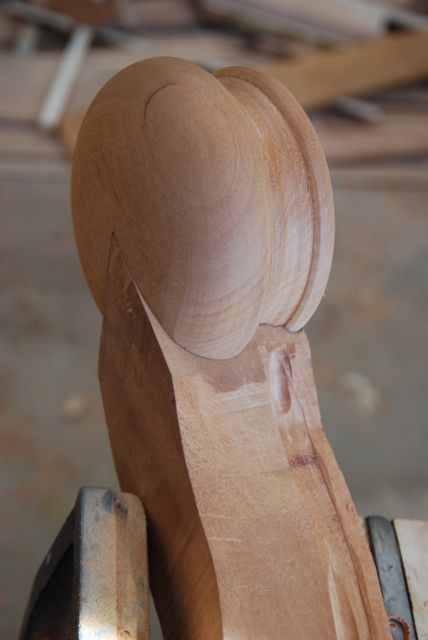
Before I could do any of the final shaping I had to take the three pieces back to the hotel and cut them to exact length and fit them up against the existing piece of handrail on the balustrade.
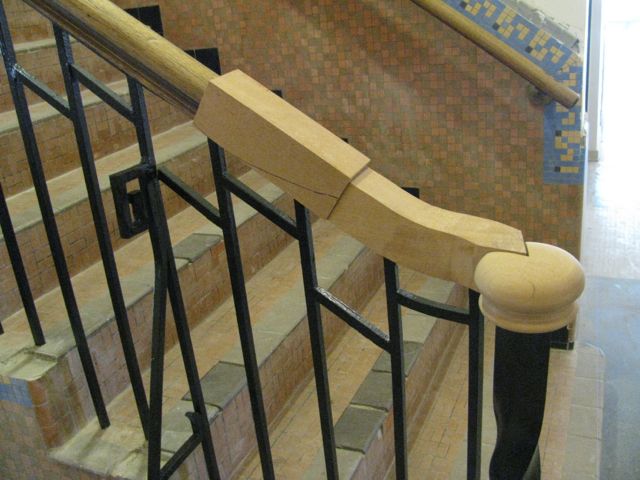
Now that I knew that they all fit, I clamped them in place and very carefully scribed the profile from the end of the old handrail and took them back to the shop for shaping.
First I shaped the straight section. That was a series of cuts on the router table with a rabbeting bit and a bullnose bitt.
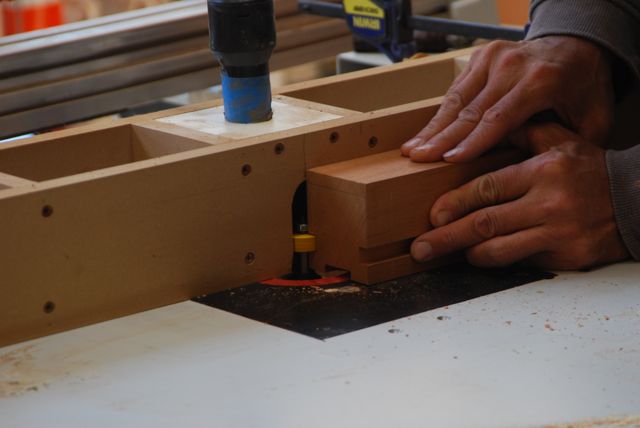
That brought me to this point. Then I table sawed the top corners off at 45 degrees and handplaned to the scribe line on the top. The curves on the bottom of this section were all hand carved.
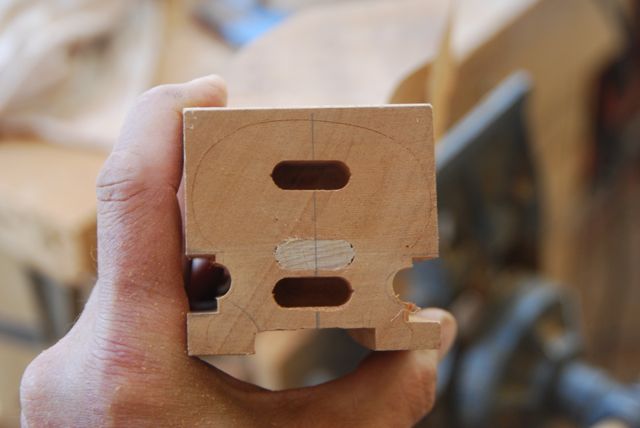
Once the straight section was done I mated it to the curved section and scribed the profile onto the uphill end of the curved piece. The profile was scribed from the volute to the downhill end. Now I had a compound curving piece that had to have some geometric shapes cut into it. Not being a super talented carver, I wanted to figure out how to cut the fillets and coves with a machine somehow. That would give me some reference points to begin carving the rest of the profile from.
I finally decided that the easiest and fastest way to go about that was to do a little funky work with the trim router and a fence. It was a strange rolling cut but it worked. First I cut the fillets and then I went back with a bullnose bitt and routed in the cove.
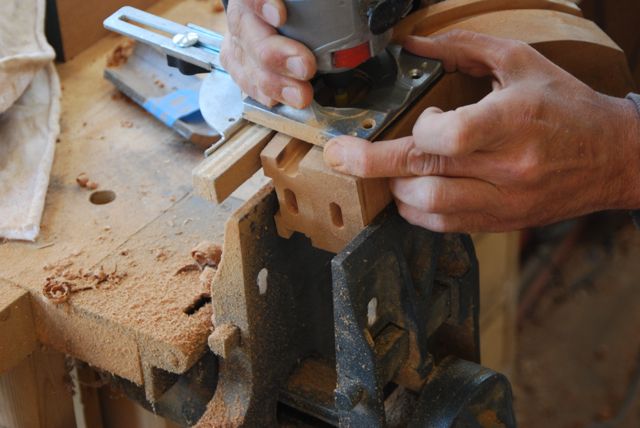
With the fillets located I could go in with hand tools and carve the rest of the shape.
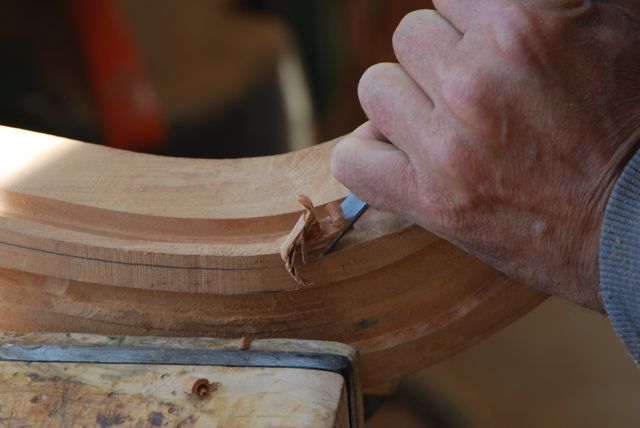

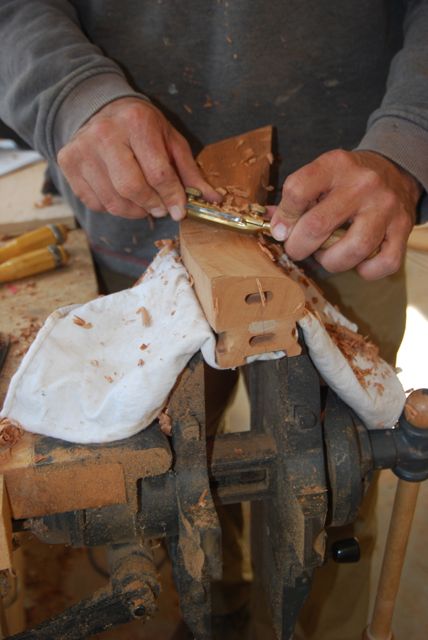
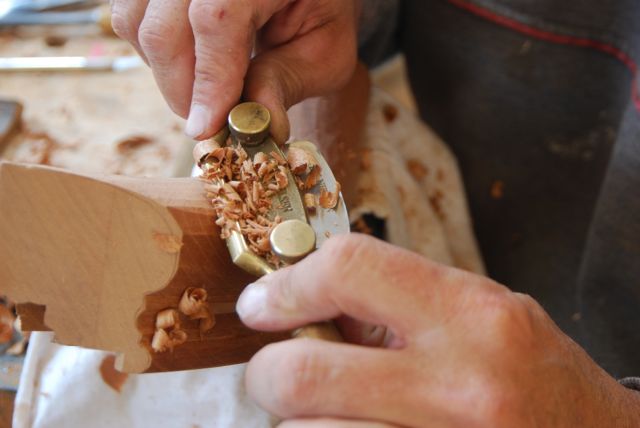
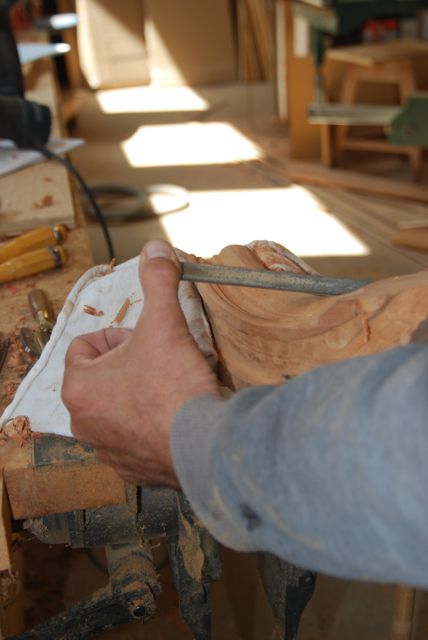
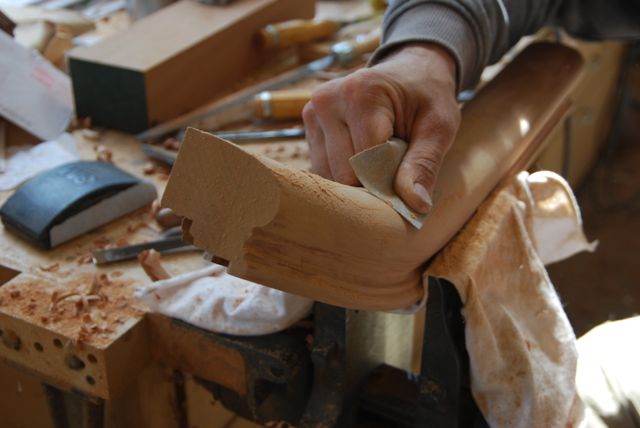
When all three pieces were shaped I put them back on the template to be sure that everything fit together nicely, then I glued them all together.
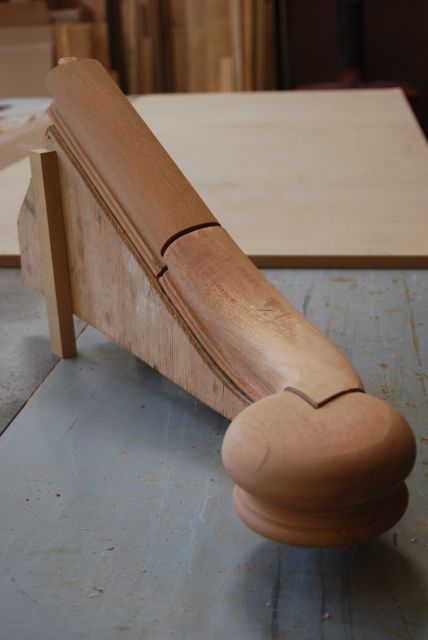
Matching the finish to the existing piece of handrail was the last detail before bringing it back to the hotel for install. I've done enough finishing to know that this was out of my league for sure. This was a job for the guy we call "Can-Do-Barry". If it needs to be right he can do it. Barry Metzger is the Man when it comes to doing faux finishes on things like this. Not only did he get the color and the sheen right, but he did some light distressing and even put a little schmutz into the cove on the bottom to match the crud that the original had from the last 80 years of use. This was a no brainer for Barry. He usually spends his days restoring and repairing antiques in his shop in Santa Fe.
When Barry was done all I had to do was pop it onto the balustrade and screw it in place. In the end I think I spent more time per inch than any other project I've ever worked on.









